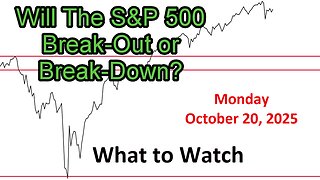Premium Only Content

Deep Dive Update for Monday October 20, 2025
Link to The SPX Investing Program https://spxinvesting.substack.com
Link to The Daily Pivot Newsletter: https://thedailypivotnewsletter.substack.com/
Link to Video-Only Immediate Access:
https://spxvideos.substack.com/
The "Deep Dive Video Update" is a weekly video that reviews charts used in daily videos, focusing on those no longer featured daily and some unique to this update, prepared for Monday, October 20th. The goal is to gain deeper insights into market trends.
Key Points:
Long-Term VIX Analysis:
The VIX (Volatility Index) is tracked with a 50-period exponential moving average. Lower VIX levels indicate an uptrend, while higher levels suggest a downtrend. Currently, the VIX is in a lower area but rising slightly, showing some market apprehension since a significant down day the previous Friday.
Short-term trend (below 20-period moving average) is negative, but intermediate (above 50-period) and long-term trends remain positive. A sustained VIX rise above 20 could signal a more negative market.
VIX momentum has been flat but is drifting upward. A spike above 70 occurred on the big down day, but it has since retreated. VIX above 20 is linked to negative annualized returns, with lower VIX levels being market-positive.
The SKEW index (a VIX variant) isn’t in the red zone, indicating no extreme fear recently.
Market Correlations and Sentiment:
A VIX-S&P correlation spiked before the recent decline but has since dropped, suggesting a potential short-term pullback rather than a major downturn.
Large-cap growth, a market driver, is moving sideways, staying above key moving averages (50, 100, 200), indicating a positive but unconvincing trend. Support levels are being watched closely.
The large-cap-to-small-cap ratio shows large caps outperforming, with no strong conviction for small caps despite occasional gains.
Market Indicators:
High-beta-to-low-beta ratios lack conviction, reflecting choppy market action.
Advance-decline ratios (price and volume) are slightly positive but show no strong momentum. Cumulative advance-decline lines for the S&P and NYSE are near their 50-day moving averages, indicating a lack of clear direction.
The 10-day average of S&P highs and lows is above 50, positive but without strong conviction. A five-period high-minus-low metric is also above zero but declining.
Index Rankings and Trends:
NASDAQ Composite leads at 90.9, followed by NASDAQ 100 (89.5), small caps (83.7), S&P (78.8), Dow (60.2), and mid-caps (47.6, underperforming).
Short-term rainbow indicator shows the market in the middle of the 10-to-50-period range, with some lines curling over, hinting at a potential negative shift. The intermediate-term rainbow remains positive, above the 50-day moving average.
Other Technicals:
The "boom indicator" (distance from moving averages) shows the market nearing the 20-period moving average but not extreme. Other oscillators (CMB Composite, Conor's RSI) are neutral.
The S&P 500 is about 10% above the 200-day moving average, down from a high of 12%. Historical overextensions (13-14%) led to declines, so this is monitored.
Bollinger Bands show no extreme readings; the market is below the midpoint, slightly negative.
The Mass Index is close to signaling a potential reversal but hasn’t met all criteria. Long-term indicators (Special K, rainbow chart) remain positive but show slight weakening.
Sector and Ratio Analysis:
Growth-to-value ratios (e.g., Qs to Dow) suggest a defensive market shift, with value outperforming slightly.
Staples-to-tech and staples-to-S&P ratios are rising, indicating defensiveness. Emerging markets vs. developed markets are range-bound but slightly higher.
US 10-year yield minus German 10-year yield shows decoupling, with German stocks holding up better recently.
Inflation concerns are low, as shown by declining bond-related ratios. Long-term bond and S&P correlations remain strong, moving inversely.
Key Sectors:
Semiconductors performing well, homebuilders are rebounding due to falling interest rates, transports are flat, retail is pulling back, and regional banks weakened significantly due to recent negative news about smaller banks.
Utilities are strong, causing ratios like hotels-to-utilities to decline, reflecting defensiveness.
Internal Market Health:
Stocks above their 200-day moving averages are positive but declining. Stocks above 50-day moving averages are below 50 for mid-caps and small-caps, showing internal weakness not yet fully reflected in prices.
PDF of Slides:
https://drive.google.com/file/d/1lNWUnddhka6hWxaUSHt-9ZerLO8WSVoU/view?usp=sharing
DISCLAIMER This video is for entertainment purposes only. I am not a financial adviser, and you should do your own research and go through your own thought process before investing in a position. Trading is risky!
-
 38:11
38:11
The SPX Investing Program
3 days agoWhat to Watch Update for Monday October 20, 2025
78 -
 LIVE
LIVE
The Mike Schwartz Show
2 hours agoTHE MIKE SCHWARTZ SHOW Evening Edition 10-22-2025
3,131 watching -
 1:27:14
1:27:14
Kim Iversen
3 hours agoCBS Boss Colluded With Israel to SPY on Americans | Trump Keeps Bombing Fisheman
45.8K81 -
 1:02:18
1:02:18
TheCrucible
3 hours agoThe Extravaganza! EP: 58 with Guest Co-Host: Rob Noerr (10/22/25)
65K9 -
 LIVE
LIVE
StoneMountain64
6 hours agoBattlefield 6 New Season Details NO 'BR' MENTIONED YET
42 watching -
 17:47
17:47
Bearing
11 hours agoThe Most ANNOYING Podcast EVER 💥 ROSIE O’DONNELL & ABBIE CHATFIELD Whinge About EVERYTHING 🤡
11.9K23 -
 LIVE
LIVE
GritsGG
5 hours agoRanked Top 70! Most Wins in WORLD! 3744+!
55 watching -
 1:52
1:52
NAG Daily
4 days agoTHE BIGGEST CREATOR COLLAB SHOW ON RUMBLE W/GreenMan Reports
11.5K2 -

Tundra Tactical
3 hours ago $5.08 earnedProfessional Gun Nerd Plays Battlefield 6
16.7K1 -
 55:25
55:25
Dad Saves America
7 hours ago $1.76 earnedWill China Overtake America? Balaji Srinivasan VS Steve Bannon on the Trade War
16.5K4